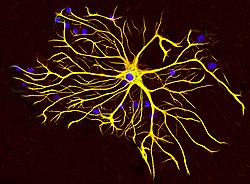Astrocytes (from Ancient Greek ἄστρον, ástron, "star" + κύτος, kútos, "cavity", "cell"), also known collectively as astroglia, are characteristic star-shaped glial cellsin the brain and spinal cord. They perform many functions, including biochemical support of endothelial cells that form the blood–brain barrier,[1] provision of nutrients to the nervous tissue, maintenance of extracellular ion balance, regulation of cerebral blood flow, and a role in the repair and scarring process of the brain and spinal cord following infection and traumatic injuries.[2] The proportion of astrocytes in the brain is not well defined; depending on the counting technique used, studies have found that the astrocyte proportion varies by region and ranges from 20% to 40% of all glia.[3] Another study reports that astrocytes are the most numerous cell type in the brain.[2] Astrocytes are the major source of cholesterol in the central nervous system.[4] Apolipoprotein E transports cholesterol from astrocytes to neurons and other glial cells, regulating cell signaling in the brain.[5] Astrocytes in humans are more than twenty times larger than in rodent brains, and make contact with more than ten times the number of synapses.[6]
Research since the mid-1990s has shown that astrocytes propagate intercellular Ca2+ waves over long distances in response to stimulation, and, similar to neurons, release transmitters (called gliotransmitters) in a Ca2+-dependent manner.[7] Data suggest that astrocytes also signal to neurons through Ca2+-dependent release of glutamate.[8] Such discoveries have made astrocytes an important area of research within the field of neuroscience.
- Circadian clock: Astrocytes alone are sufficient to drive the molecular oscillations in the SCN and circadian behavior in mice, and thus can autonomously initiate and sustain complex mammalian behavior.[33]
https://en.wikipedia.org/wiki/Astrocyte
https://en.wikipedia.org/wiki/SLIT1
https://en.wikipedia.org/wiki/Reelin
https://en.wikipedia.org/wiki/NKX6-1
https://en.wikipedia.org/wiki/PAX6
https://en.wikipedia.org/wiki/Wnt_signaling_pathway
https://en.wikipedia.org/wiki/Bone_morphogenetic_protein
https://en.wikipedia.org/wiki/Astrocyte

No comments:
Post a Comment